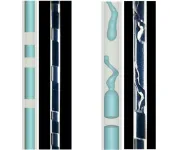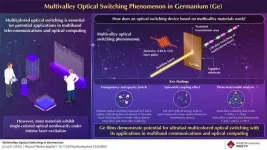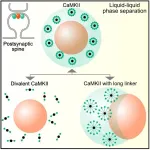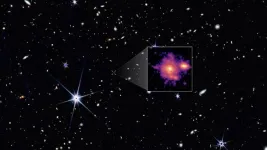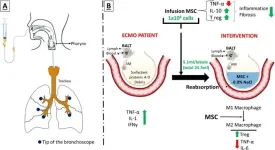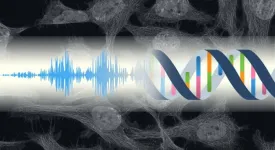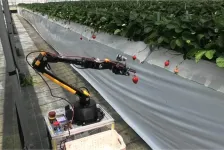(Press-News.org) When two materials come into contact, charged entities on their surfaces get a little nudge. This is how rubbing a balloon on the skin creates static electricity. Likewise, water flowing over some surfaces can gain or lose charge. Now, researchers reporting in ACS Central Science have harnessed the phenomenon to generate electricity from rain-like droplets moving through a tube. They demonstrate a new kind of flow that makes enough power to light 12 LEDs.
“Water that falls through a vertical tube generates a substantial amount of electricity by using a specific pattern of water flow: plug flow,” says Siowling Soh, the study’s corresponding author. “This plug flow pattern could allow rain energy to be harvested for generating clean and renewable electricity.”
When running water moves a turbine, it generates electricity. However, hydroelectricity is constrained to locations with large volumes of water, like rivers. For smaller and slower volumes of water, an alternative is to harness charge separation, a phenomenon that produces electrical charges as water moves through a channel with an electrically conductive inner surface. But charge separation is extremely inefficient because it is restricted to the surface that the water moves over. Previously, scientists have tried to improve its efficiency by making more surface area available through micro- or nanoscale channels for a continuous stream of water. However, water doesn’t naturally pass through such tiny channels, and if pumped, it requires more energy than gets generated. So, Soh, Chi Kit Ao and colleagues wanted to produce electricity using larger channels that rainwater could pass through.
The team designed a simple setup whereby water flowed out the bottom of a tower through a metallic needle and spurted rain-sized droplets into the opening of a 12-inch-tall (32-centimeter-tall) and 2-millimeter-wide vertical polymer tube. The head-on collision of the droplets at the top of the tube caused a plug flow: short columns of water interspersed with pockets of air. As water flowed down the inside of the tube, electrical charges separated. The water was then collected in a cup below the tube. Wires placed at the top of the tube and in the cup harvested the electricity.
The plug flow system converted more than 10% of the energy of the water falling through the tubes into electricity. And compared to water flowing in a continuous stream, plug flow produced 5 orders of magnitude more electricity. Because the droplet speeds tested were much slower than rain, the researchers suggest the system could be used to harvest electricity from falling raindrops.
In another experiment, the researchers observed that moving water through two tubes, either simultaneously or sequentially, generated double the energy. Using this information, they channeled water through four tubes, and the setup powered 12 LEDs continuously for 20 seconds. The researchers say that plug flow energy could be simpler to set up and maintain than hydroelectric power plants, and it could be convenient for urban spaces like rooftops.
The authors acknowledge funding from the Ministry of Education, Singapore; the Agency for Science, Technology and Research; and the Institute for Health Innovation & Technology at the National University of Singapore.
The paper’s abstract will be available on April 16 at 8 a.m. Eastern time here: http://pubs.acs.org/doi/abs/10.1021/acscentsci.4c02110
###
The American Chemical Society (ACS) is a nonprofit organization chartered by the U.S. Congress. ACS’ mission is to advance the broader chemistry enterprise and its practitioners for the benefit of Earth and all its people. The Society is a global leader in promoting excellence in science education and providing access to chemistry-related information and research through its multiple research solutions, peer-reviewed journals, scientific conferences, e-books and weekly news periodical Chemical & Engineering News. ACS journals are among the most cited, most trusted and most read within the scientific literature; however, ACS itself does not conduct chemical research. As a leader in scientific information solutions, its CAS division partners with global innovators to accelerate breakthroughs by curating, connecting and analyzing the world’s scientific knowledge. ACS’ main offices are in Washington, D.C., and Columbus, Ohio.
Registered journalists can subscribe to the ACS journalist news portal on EurekAlert! to access embargoed and public science press releases. For media inquiries, contact newsroom@acs.org.
Note: ACS does not conduct research but publishes and publicizes peer-reviewed scientific studies.
Follow us: Facebook | LinkedIn | Instagram
END
COLUMBUS, Ohio – A new study offers clarity on one of the most common questions asked of financial professionals: Is term or permanent life insurance right for me?
Researchers at The Ohio State University conducted a study of how different life insurance product types were related to whether households had adequate financial resources if an income earner died.
They didn’t compare permanent and term life insurance directly, but they calculated how likely households with different life ...
Opaque materials can transmit light when excited by a high-intensity laser beam. This process, known as optical bleaching, induces a nonlinear effect that temporarily alters the properties of a material. Remarkably, when the laser is switched on and off at ultrahigh speeds, the effect can be dynamically controlled, opening new possibilities for advanced optical technologies.
Multicolored optical switching is an important phenomenon with potential applications in fields such as telecommunications and optical computing. However, most materials typically exhibit single-color optical nonlinearity under intense laser illumination, ...
Our brain’s remarkable ability to form and store memories has long fascinated scientists, yet most of the microscopic mechanisms behind memory and learning processes remain a mystery. Recent research points to the importance of biochemical reactions occurring at postsynaptic densities—specialized areas where neurons connect and communicate. These tiny junctions between brain cells are now thought to be crucial sites where proteins need to organize in specific ways to facilitate learning and memory formation.
More specifically, a 2021 study revealed that memory-related proteins can bind together to form droplet-like structures ...
Plants store carbon in two primary forms: starch and triacylglycerols (TAGs). Starch is mainly stored in chloroplasts in leaves, where it serves as a readily available energy source, while TAGs are stored in seeds for long-term energy storage. Past studies have shown that a carbon trade-off exists between these two storage forms, implying that an increase in the levels of one form often reduces the levels of the other. Interestingly, attempts to increase TAG in leaves have led to a decrease in the levels of starch, suggesting ...
An international team led by the University of Geneva (UNIGE) has discovered the most distant spiral galaxy candidate known to date. This ultra-massive system existed just one billion years after the Big Bang and already shows a remarkably mature structure, with a central old bulge, a large star-forming disk, and well-defined spiral arms. The discovery was made using data from the James Webb Space Telescope (JWST) and offers important insights into how galaxies can form and evolve so rapidly in the early Universe. The ...
A multidisciplinary clinical team led by Professor Bernat Soria from the Institute of Bioengineering at the Miguel Hernández University of Elche (UMH, Spain) has developed a new method to deliver cell therapies in patients on extracorporeal membrane oxygenation (ECMO), a life support system used in cases of severe lung failure. The advance has been published in Stem Cell Research & Therapy (Springer Nature Group). The team has opted not to patent the technique in order to encourage its use in public health systems ...
A new study from University of California San Diego suggests that climate trauma — such as experiencing a devastating wildfire — can have lasting effects on cognitive function. The research, which focused on survivors of the 2018 Camp Fire in Northern California, found that individuals directly exposed to the disaster had difficulty making decisions that prioritize long-term benefits. The findings were recently published in Scientific Reports, part of the Nature portfolio of journals.
“Our previous research has shown that survivors of California’s 2018 Camp Fire experience prolonged symptoms ...
Kyoto, Japan -- There's a sensation that you experience -- near a plane taking off or a speaker bank at a concert -- from a sound so total that you feel it in your very being. When this happens, not only do your brain and ears perceive it, but your cells may also.
Technically speaking, sound is a simple phenomenon, consisting of compressional mechanical waves transmitted through substances, which exists universally in the non-equilibrated material world. Sound is also a vital source of environmental information for living beings, while its capacity to induce physiological responses at the cell ...
Strawberry fields forever will exist for the in-demand fruit, but the laborers who do the backbreaking work of harvesting them might continue to dwindle. While raised, high-bed cultivation somewhat eases the manual labor, the need for robots to help harvest strawberries, tomatoes, and other such produce is apparent.
As a first step, Osaka Metropolitan University Assistant Professor Takuya Fujinaga has developed an algorithm for robots to autonomously drive in two modes: moving to a pre-designated destination and moving alongside ...
By Dr Kelly Dunning
The Endangered Species Act (ESA), now 50 years old, was once a rare beacon of bipartisan unity, signed into law by President Richard Nixon with near-unanimous political support. Its purpose was clear: protect imperiled species and enable their recovery using the best available science to do so. Yet, as our case study on the grizzly bear in the Greater Yellowstone Ecosystem reveals, wildlife management under the ESA has changed, becoming a political battleground where science is increasingly drowned out by partisan ideology, bureaucratic delays, power struggles, and competing political interests. ...
